What do scoops look like and how to deal with pests?
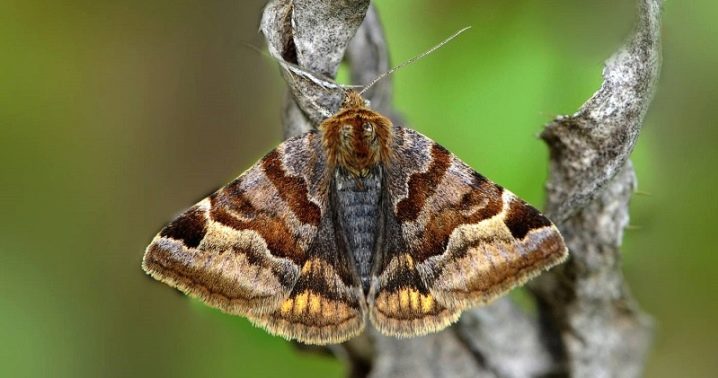
Garden and horticultural crops are very often affected by all kinds of pests. One of the most common pests is the moth, a moth that can cause tremendous damage to plants. The features of such a parasite and methods of dealing with it should be known to every summer resident.
What it is?
Scoops belong to the Lepidoptera family. These are unremarkable butterflies, which, regardless of the species, have an inconspicuous color: brown, gray, brownish. The sizes of insects differ: there are both very small butterflies of 10 mm, and representatives of larger ones, reaching 130 mm. The wingspan will also vary. The wings resemble a triangle in shape, while the front ones are always longer. On the wings there is a peculiar pattern, which is popularly called the "scoop pattern". The spots are not uniform in length and size. The hindwings are shorter than the forewings and are definitely brighter.
There are insects even with red or blue hind wings.
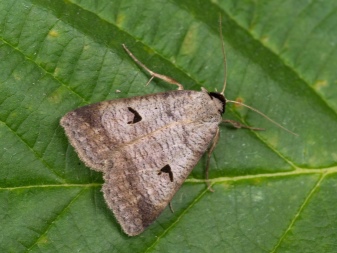
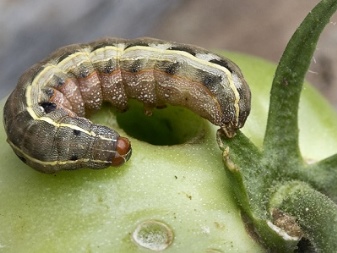
The scoop is a nocturnal insect, almost never seen during the day. In the dark, the butterfly is laying eggs. The first clutches can be seen already a day after the beginning of the flight of insects, but the main part of the eggs is laid in a week. Most often, the masonry is located on the lower parts of the sheet plate. Eggs are yellow-green, tiny, in one clutch there can be up to 200 of them. If the weather is stable, the eggs will hatch in a couple of days. The appeared caterpillars can have different colors. So, the most common are green individuals, but there are both brown and gray pests. The young feed on the sap of the foliage, nibbling at the edges. Growing up, the caterpillars move to the central parts of the leaf plates, and they also begin to eat the fruits of garden crops, flowers. Some varieties parasitize inside the stems (intrastem).
After some time, the caterpillar turns into a pupa. The pupation process in most species occurs in the ground, but pupae can also be found in dead leaves and plant debris. Pupation takes from a week to a month, depending on the species. Then the next generation butterfly emerges from the cocoon, and the cycle begins anew. Moths inhabit almost the entire territory of the globe. They even live in arctic deserts, on mountain tops, in the tundra. In total, about 35 thousand species of such insects have already been studied on the planet. The number of species in Russia is 2 thousand.
Parasites infect a huge number of plants. They live on vegetables, flowers, and even weeds.
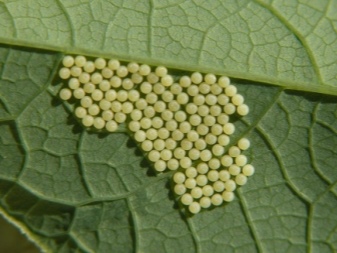

Description of species
Despite the fact that there are a lot of scoop species, not all of them are widespread. Gardeners have identified several varieties most commonly found in greenhouses and gardens in the country.
Winter
The winter scoop is one of the subspecies of the gnawing butterfly.... The insect is quite large, it looks like a night moth. The color is mostly gray or gray-brown, but yellowish specimens are also found. The first butterflies of winter moths begin to fly at the end of May. They place their masonry both on the ground and on the lower part of the leaf plates. Caterpillars appear after about 14 days.
In the daytime, insects hide, and at night they go out in search of food. They eat seeds, young growth, gnaw the stems, suck the juice from the leaves. Caterpillars have an enviable appetite, not disdaining anything.The parasites eat corn, grapes, cucumbers and tomatoes, and peppers. Often they can be found on fruit trees. In the autumn, the caterpillars go to the ground. There they easily endure frosts, and in the spring they pupate and turn into butterflies.
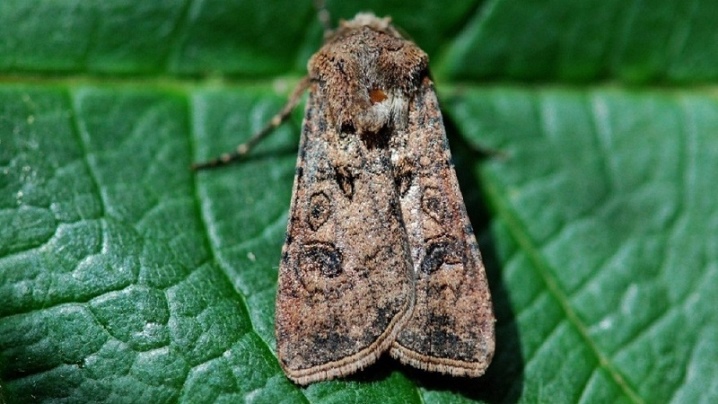
Ogorodnaya
This is the most popular species among the scoops. The butterfly is large, with reddish wings. The insect begins to fly in May, immediately laying eggs. One clutch will contain up to 70 eggs. Caterpillars are green or yellowish in color. The emerging parasites are especially fond of cruciferous crops. But they will also like potatoes, carrots, cucumbers. Older caterpillars completely consume the foliage, leaving only veins.
The largest butterflies appear if the clutch was on sunflowers or beets. The development of caterpillars on these plants progresses much faster. Insects prefer to overwinter in the soil.
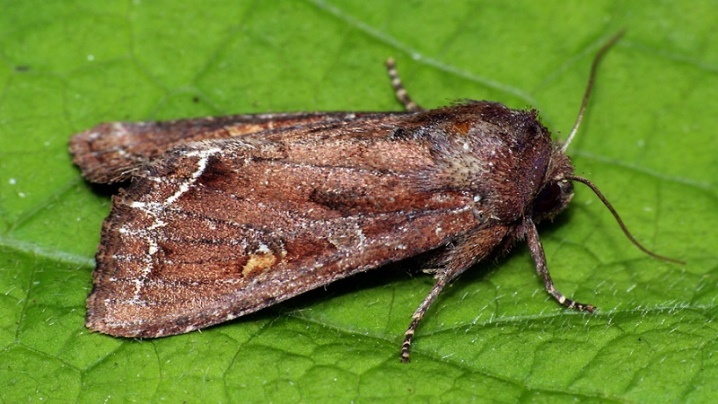
Cabbage
Another ubiquitous variety of garden pests. The cabbage scoop is a gray or gray-brown moth with a wingspan of approximately 5 centimeters. A clear pattern with yellow torn stripes and two large spots is visible on the wings.
The pest does not differ in increased fertility, but from this it does not cease to be dangerous. The favorite food of cabbage scoops is, of course, cabbage, and this is where they lay their eggs. Young caterpillars eat the foliage, and those that are older make their way into the heads of cabbage. Then you cannot eat such products, and in the garden they become a breeding ground for bacteria. In addition to cabbage, moth caterpillars can infect beets, grapes, tobacco leaves, peas, sunflowers and other plants in the garden.
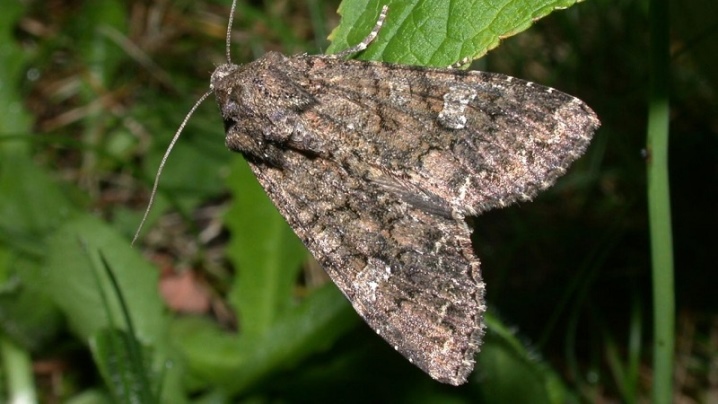
Pine
This butterfly damages deciduous and pine trees... It mainly eats pine, cedar, juniper and other similar plants. On deciduous trees, it is less common, but this is also quite possible. The pine scoop has a wingspan of about 35 mm. The color can be gray, brown or reddish. Eggs are predominantly white, sometimes yellow with a green tint. Caterpillars are green.
Years of the pine scoop begin in March and end in May. The clutches are located on the needles, the first larvae appear after 3 weeks. Young caterpillars prefer May coniferous shoots, and older specimens eat any needles. In early summer, the caterpillar pupates in the soil and sleeps until the next spring. In March, butterflies emerge from pupae, immediately starting to lay eggs.
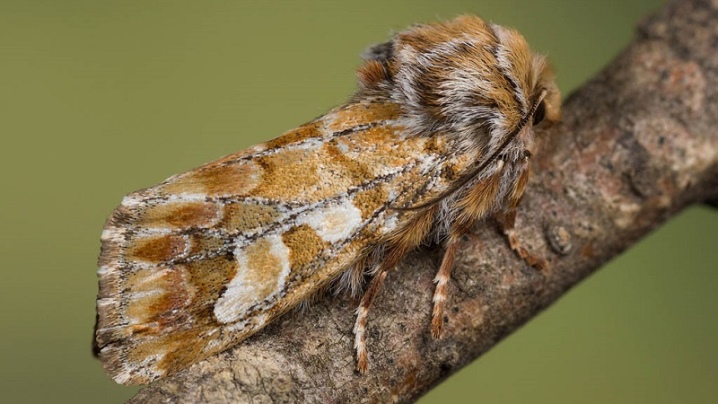
Metallic gamma
Large gray butterfly with a wingspan of 40 mm. It got its name from the white speck on the wings, reminiscent of the letter of the same name in the Greek alphabet. Butterflies begin their years as soon as the air warms up to 20 degrees Celsius. Most of the clutches are located on weeds, but eggs can also be found on beets, potatoes, and green peas.
Caterpillars quickly eat leaves, as well as flowers and buds. Having finished with one plant, they move to the next. They hibernate in the soil, withstand the cold well. If there was a lot of snow in winter, butterflies will turn out to be even more fertile.
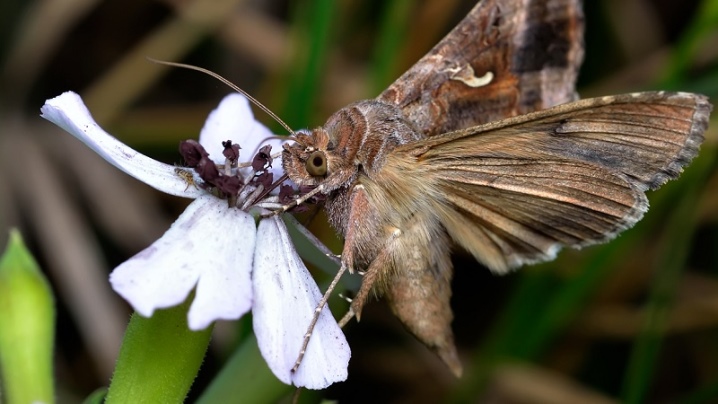
Exclamation
Such moths are very common in many regions of the country, they are found even in Siberia. The color is different, there are both yellowish and brown individuals. Caterpillars are mostly gray with a brown tint.
Exclamation moths begin to fly at the end of the last month of spring, and they place their clutches on the remains of plants and fallen leaves, sometimes directly on the soil. Caterpillars feed on all kinds of plants, including foliage of fruit trees and grains.
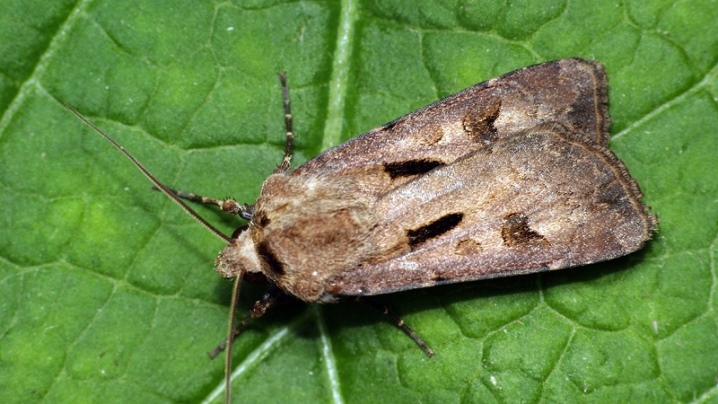
Alfalfa
This scoop has an unremarkable appearance and medium size.... Butterfly caterpillars love alfalfa, clover, sunflowers, peanuts, and a variety of vegetables. Quite often, the pest parasitizes on medicinal herbs. The butterfly is gray; green and yellow overflows are also traced in the wings. In the northern regions, insects first appear in July, in the southern ones - in April.The eggs of such a butterfly are first white, then turn green or orange. After about a week, the eggs hatch into larvae. Caterpillars eat green mass, flowers and seeds, after a month they pupate in the ground. The emerging butterfly immediately makes a clutch and dies.
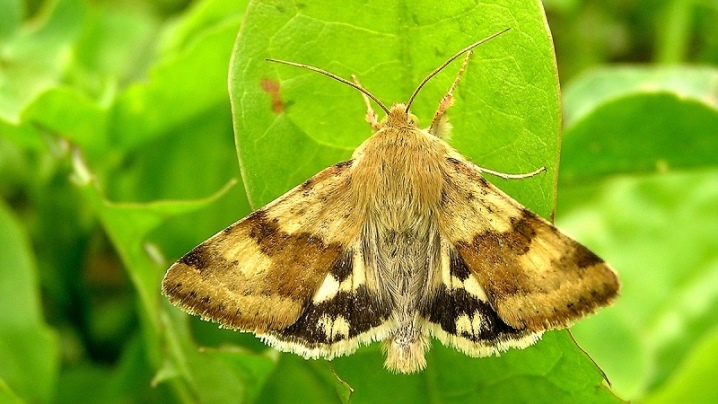
Grain gray
This parasite damages crops. It feeds on wheat, millet, barley and other similar plants. The butterfly has a gray color with an orange tint, its size is medium. Summer starts in May, at the same time the butterfly lays eggs. They are white, like even balls. Caterpillars are brown, at first they live inside the ovaries, later they move to open space. Insects hibernate in the upper layers of the soil or under plant debris.

Tape
There are several types of tapeworms. There are large, medium and small specimens. For the most part, butterflies are brown, they are found not only in summer cottages, but also in arable land, in forests, ravines, gardening areas. They start flying in June, then there is a pause. The next years are celebrated in August. In one year, butterflies give only one generation.
Caterpillars feed on clover, grapes, ornamental crops, sorrel, nettle.

Earthy gray
The gray scoop is one of the largest representatives of the earthworm. White spots are clearly visible on the wings. Mostly such butterflies are found in forest zones, but they can also fly to summer cottages.
Only one generation of insects appears per year. Earthen gray moths begin to fly in June and end in September. Young caterpillars are yellow, with a gray tint and a light stripe on the back. They feed on raspberries, dandelions, blackberries, grapes and many other crops.
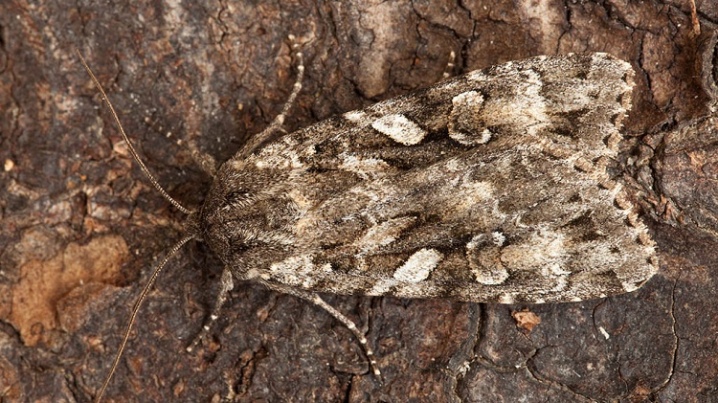
Potato
It is a brown butterfly with red tints on its wings. Years begin towards the end of summer, eggs are laid in the foliage. In this case, the insect prefers leaf plates of cereals. Caterpillars appear in April, their distinctive feature is a red stripe on the back. First, they eat cereals, then move to other plants.
Despite the name, the potato scoop parasitizes not only potatoes. She also loves tomatoes, garlic, strawberries very much. He does not disdain flowers either. Caterpillars are not sent for wintering. This subspecies of scoops spends the winter in the form of masonry.
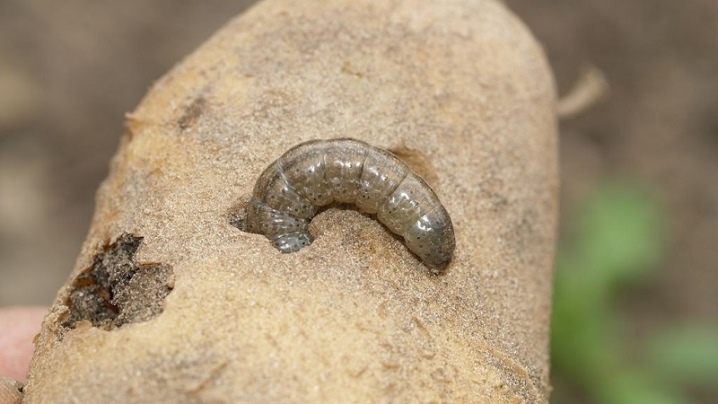
Cotton
This species of scoop has a gray-yellow color of the wings. Caterpillars can be brown, green or white. The masonry is located on any part of the crops. Over the entire summer period, butterflies make several clutches, thus creating a number of generations at once.
Caterpillars eat leaves, peduncles, fruits. They parasitize bell peppers, zucchini and pumpkin, tomatoes, cucumbers, cabbage. Very often young growth appears on the leaves of fruit trees, causing irreparable damage to the latter.
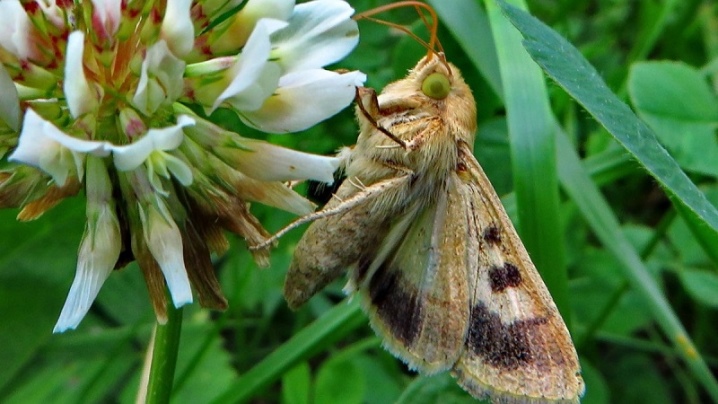
Sinegolovka
A large butterfly with lilac-gray wings. It begins to fly in autumn, laying on the branches of fruit trees. After wintering, caterpillars with a blue or blue head appear from the eggs, which led to the name of the subspecies. Caterpillars eat foliage and buds, and make their way into the fruit. Those that are older, crawl under the bark, forming cocoons there. The diet of the bluehead caterpillar includes all fruit trees, as well as berry bushes and hazel. They can often be found on deciduous trees as well.
Fun fact: the largest scoop is agrippina... The wingspan of such an individual is about 28 centimeters. The butterfly is beautiful, with a bluish tint. Lives in America and Mexico, loves hot weather. To date, agrippina has been very poorly studied, but the available research suggests that it prefers to eat legumes.
In Brazil, the butterfly is under protection, as this species is threatened with extinction.
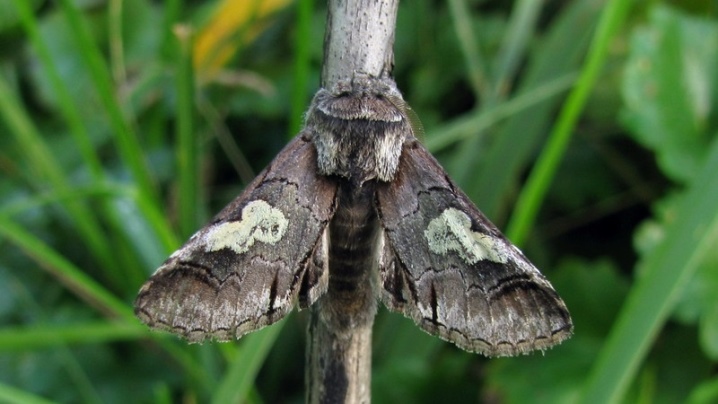
How to get rid of insects?
The scoops must be disposed of as soon as they appeared on the site.The butterflies themselves are not harmful, but their caterpillars are able to eat everything that is within reach. You can fight pests both by folk methods and by chemical means. Let's take a look at some interesting options.
- When the butterfly years begins, you need to immediately place bowls with some sweet substance on the site. It should be viscous. The insects will fly in, attracted by the sugar, and then get bogged down inside. The containers must be renewed daily.
- To prevent egg laying, you can use an infusion of wormwood. It is the flowering grass that is needed. It must be collected (about 300 grams), then chopped. Raw materials are poured with 10 liters of boiling water. As soon as the mass has cooled, it must be supplemented with wood ash (200 grams) and liquid soap (20-25 grams). It will turn out to be an excellent tool with which you can poison the arriving butterflies.
- In addition to wormwood, other plants can be used. Scoops do not like strong odors, so herbs and plants with strong odors will be able to drive them away. For use, infusions from such cultures as onions and garlic, mustard, hot peppers, and tomato tops are recommended. It is customary to carry out all spraying at night, since the butterfly does not fly during the day.
- If insects have already laid eggs, you should dig up the ground in the aisles... Then you will need to sprinkle it with crushed chicken eggshells. The method will be effective if the moths lay their eggs on the ground.
- It is easier to destroy caterpillars when they are still small.... To do this, use insecticides. Good drugs will be "Fufanon-Nova", "Decis", "Arrivo", "Confidor". It is impossible to experiment with the proportions of the poison, therefore, the dilution of the preparations is carried out in strict accordance with the instructions. Among biological control measures, Lepidocide has proven itself in the best way. For 10 liters of water, 50 grams of the product will be needed. Treatments are also carried out in the evening.


In order to prevent the appearance of scoops on their site, it will be useful for gardeners to learn about some preventive measures.
- Scoops most often appear in neglected areas with an abundance of weeds. Therefore, the weeds must be removed regularly.
- Examine the plants in your garden systematically. If masonry is found, it should be immediately removed and burned.
- After the crop is harvested, tidy up the area. Collect foliage, other plant debris, because eggs may be hiding in them. Dig up the topsoil as most moth species hibernate there.
- A good result is obtained by planting in an area of plants with a strong odor. For example, the scoop is deterred by onions, marigolds, garlic, mint and other crops.
- Beneficial birds and insect nurses can also be attracted to the sites to destroy the scoop.... This is the most harmless and effective method.
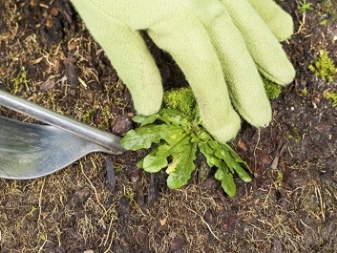














The comment was sent successfully.